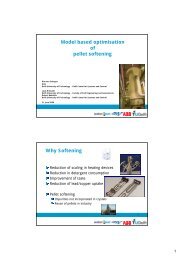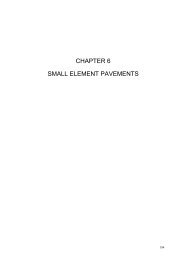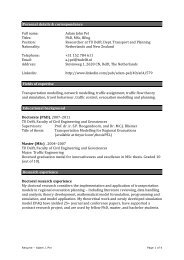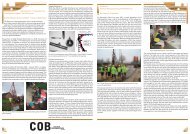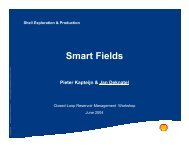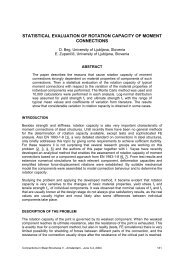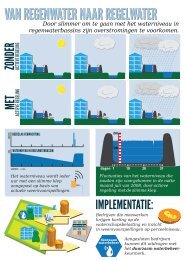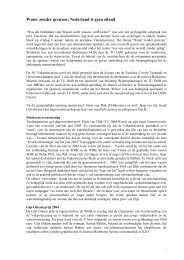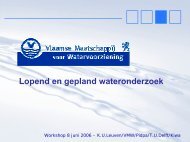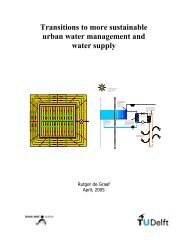Structural Design of Pavements PART VI Structural ... - TU Delft
Structural Design of Pavements PART VI Structural ... - TU Delft
Structural Design of Pavements PART VI Structural ... - TU Delft
You also want an ePaper? Increase the reach of your titles
YUMPU automatically turns print PDFs into web optimized ePapers that Google loves.
49<br />
From the equations given above it becomes clear that the quality <strong>of</strong> the predictions increases<br />
when S logN decreases. This means that S logSCI and S l<strong>of</strong> should be as low as possible. A low<br />
S logSCI stresses the need to pay ample attention to the discrimination <strong>of</strong> homogeneous subsections.<br />
The only factor that cannot be easily assessed is the variation in fatigue characteristics.<br />
Although this value can be estimated (see e.g. lecture notes CT4850 part III<br />
Asphaltic Materials) if mixture composition data are available, extensive fatigue testing has<br />
shown that S l<strong>of</strong> = 0.25 is a reasonable first estimate.<br />
Overlay calculations based on the confidence level or probability <strong>of</strong> survival level P are made<br />
in the following way. As is shown above, the number <strong>of</strong> load repetitions until a certain<br />
probability <strong>of</strong> survival level P 1 is reached can be calculated using:<br />
log N P1 = A 0 + A 1 C 0 + A 1 C 1 log SCI 1 – u 1 S logN<br />
If the pavement life has to be extended to N + ∆N load repetitions and after that number <strong>of</strong><br />
load repetitions, the probability <strong>of</strong> survival should be P 2 , the needed SCI level to achieve this<br />
can be calculated using:<br />
Log (N + ∆N) P2 = A 0 + A 1 C 0 + A 1 C 1 log SCI 2 – u 2 S log(N+∆N)<br />
After subtracting <strong>of</strong> both equations one obtains:<br />
Log {N P1 / (N + ∆N) P2 } = A 1 C 1 log {SCI 1 / SCI 2 } – u 1 S logN + u 2 S log(N+∆N)<br />
By writing<br />
N P1 / (N + ∆N) P2 = 1 / X<br />
I 1 = 10**(u 1 S logN )<br />
I 2<br />
= 10**(u 2 S log(N+∆N)<br />
We arrive to<br />
Log {1 / X} = A 1 C 1 log {SCI 1 / SCI 2 } – log I 1 + log I 2<br />
This can be written as:<br />
SCI 2<br />
= SCI 1 (X I 2 / I 1 ) 1/A1C1<br />
In these equations SCI 1 can be considered as the SCI before the overlay is placed and SCI 2<br />
as the SCI after overlaying. In the same way S logN is valid before overlaying and S log(N+∆N) is<br />
valid after the overlay is placed.<br />
We still need equations to predict the SCI 2 in relation to the overlay thickness and stiffness as<br />
well as the SCI 1 . Furthermore an equation is needed to predict S logSCI2 because from this<br />
value S log(N+∆N) can be calculated. These equations are given below:<br />
Log SCI 2 = b 0 + b 1 E o + b 2 h o + b 3 log SCI 1 + b 4 E o log SCI 1 + b 5 h o log SCI 1<br />
+ b 6 h o log E o log SCI 1<br />
S 2 logSCI2<br />
= {b 1 + b 4 log SCI 1 + b 6 h o log SCI 1 / E o } 2 S 2 Eo<br />
+ {b 2 + b 5 log SCI 1 + b 6 log E o log SCI 1 } 2 S 2 ho<br />
+ {b 3 + b 4 E o + b 5 h o + b 6 h o log E o } 2 S 2 logSCI1<br />
Where: SCI 1<br />
SCI 2<br />
h o<br />
E o<br />
= surface curvature index (d 0 – d 300 ) before overlaying [µm]<br />
= surface curvature index (d 0 – d 300 ) after overlaying [µm]<br />
= overlay thickness [mm]<br />
= elastic modulus <strong>of</strong> the overlay [Mpa]<br />
b o = -0.0506<br />
b 1 = 1.178 10 -5<br />
b 2 = 0.0094



